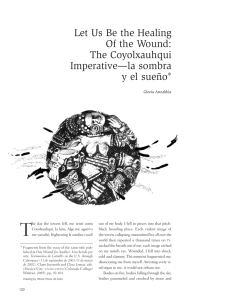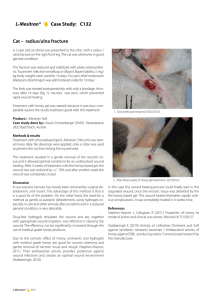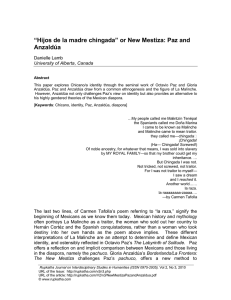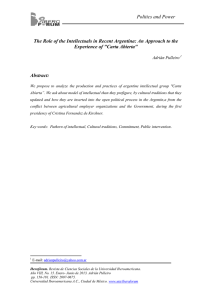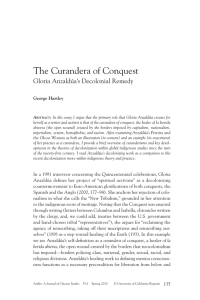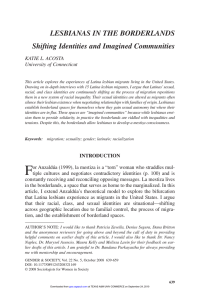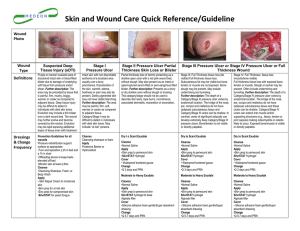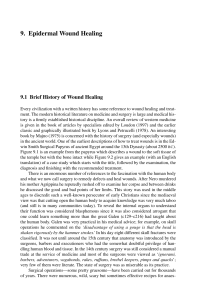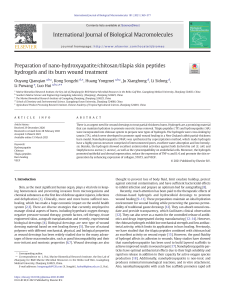Gloria Anzaldúa Bridges and Wounds
Anuncio
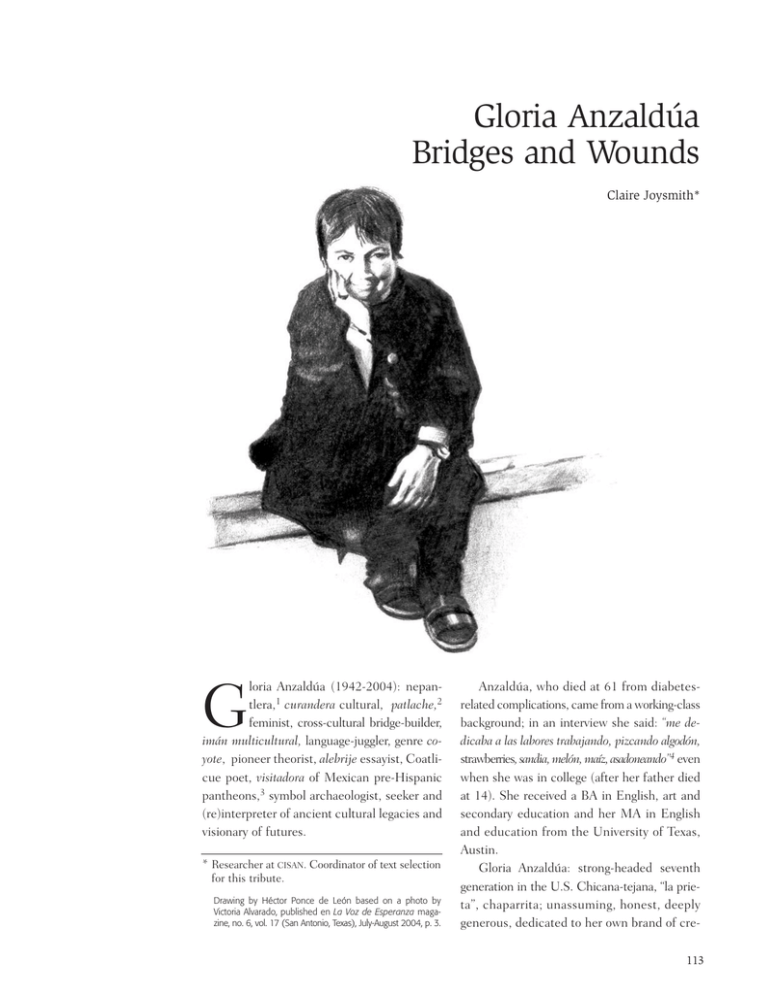
Gloria Anzaldúa Bridges and Wounds Claire Joysmith* loria Anzaldúa (1942-2004): nepantlera,1 curandera cultural, patlache,2 feminist, cross-cultural bridge-builder, imán multicultural, language-juggler, genre coyote, pioneer theorist, alebrije essayist, Coatlicue poet, visitadora of Mexican pre-Hispanic pantheons,3 symbol archaeologist, seeker and (re)interpreter of ancient cultural legacies and visionary of futures. G * Researcher at CISAN. Coordinator of text selection for this tribute. Drawing by Héctor Ponce de León based on a photo by Victoria Alvarado, published en La Voz de Esperanza magazine, no. 6, vol. 17 (San Antonio, Texas), July-August 2004, p. 3. Anzaldúa, who died at 61 from diabetesrelated complications, came from a working-class background; in an interview she said: “me dedicaba a las labores trabajando, pizcando algodón, strawberries, sandia, melón, maíz, asadoneando”4 even when she was in college (after her father died at 14). She received a BA in English, art and secondary education and her MA in English and education from the University of Texas, Austin. Gloria Anzaldúa: strong-headed seventh generation in the U.S. Chicana-tejana, “la prieta”, chaparrita; unassuming, honest, deeply generous, dedicated to her own brand of cre113 A woman-of-color who writes poetry or paints or dances or makes movies knows there is no escape from race or gender when she is writing or painting. She can’t take off her color and sex and leave them at the door of her study or studio. Nor can she leave behind her history. Art is about identity, among other things, and her creativity is political.5 ative grito de lucha. She believed in the power of the word and of artistic expression for social, political and spiritual change, fully conscious of the daunting responsibility of the committed artist and creator, believing in what she called “spiritual activism” and the urgent need to create bridges and heal wounds. Her groundbreaking book Border lands/ La Frontera. The New Mestiza was selected as one of the 100 best books of the century by Hungry Mind Review and Utne Reader. She also won numerous awards: the 1986 Before Columbus Foundation American Book Award, the Sappho Award of Distinction, National Endowment for the Arts Fiction Award, the American Studies Association Lifetime Achievement Award, among others. Yet, she was too radical for many, which meant she did not receive the recognition to which her body of work is entitled. Anzaldúa was able to address the taboo, say the unsayable, because, as she explained, “[las lesbianas] no longer have much to lose because once you reveal in your writing who you are and your experiences, you hardly have any secrets to hide.”6 Anzaldúa’s much-quoted “The U.S.Mexican border es una herida abierta where the Third World grates against the First and bleeds. And before a scab forms it hemorrhages again, the lifeblood of two worlds merging to form a new country— a border culture,” from Borderlands/La Frontera. The New Mestiza7 has perhaps been overused and even misused at times. It is, however, among several of the legacies she contributed to literary, cultural, gender, queer and Chicana/o theory. So are some of her key concepts: Borderlands, the Coatlicue state, el Mundo Zurdo, the Coyolxauhqui imperative and Nepantla.8 In her post 9/11 testimonio written in March 2002, “Let Us Be the Healing of the Wound: The Coyolxauhqui Imperative—La sombra y el sueño,” which was to be one of her last written and published texts, she (ad)dressed wounding and healing in words that hark back to —and yet shift— her renowned quote about the border as una herida abierta: “We are all wounded but we can connect through the wound that’s alienated us from others. When the wound forms a cicatrize, the scar can become a bridge linking people split apart.”9 I met Gloria in Mexico City, at the UNAM, at a multicultural meeting in which the CISAN was participating as co-organizer in 1992. Hardly anybody was there. She had recently been diagnosed with diabetes. We had lunch at La Fonda de Santa Anita in the Zona Rosa. And as I interviewed her after lunch, she spoke mostly in Spanish; as she tired, she gradually used more English.10 When I heard of her death I wrote: gloria: i met you when you gave a talk in Mexico city cerca del día de los muertos in 1992…i realized your audience had little or no understanding of what you were talking about...and yet these were your Editor of This Bridge Called My Back: Writings by Radical Women of Color, with Cherríe Moraga (1981). Making Face, Making Soul/Haciendo Caras: Creative and Critical Perspectives by Women of Color (1990). This Bridge We Call Home: Radical Visions for Transformation (2002). Interviews/Entrevistas, with AnaLouise Keating (2002). 114 mexican “cousins”…you stood up, said what you had to say…i remained amazed…when i interviewed you i discovered a warm, strong, intuitive curandera-escritora of many striking ideas and words…shortly after i began working on ways to facilitate further understanding in México of what it might mean to be chicana/chicano…and on how that could help us to learn as mexicanas/mexicanos who happen to be on this side of the “herida abierta” border, about the depths and widths of mexicanidades…every time i was faced with what i have termed “reactive resistances” in audiences in Mexico i always remembered how you stood up and said what you had to say….today i dedicate the transborder work i have done in Mexico to your memory con profunda gratitud. Her writings and the practice of her own theories have influenced very many, even though this is not so visible in Mexico as yet. When she came to the UNAM in 1992, however, it was the beginning of her bridge-crossing back into Mexico. When more of her work is translated into Spanish, and becomes more easily available de este lado, on this side of the herida abierta border, many more, it is hoped, may be able to benefit. Anzaldúa has left a legacy for us, for future generations. She insisted, more so after 9/11: “ Let us fight no more but heal the wounds of nations. Let us be the healing of the wound.’”11, a call to intense, sensitive, critical, intelligent, in-formed, heart-felt “spiritual activism”. But it is the determined simplicity of her words “May we do work that matters”12 that, at least in my mind, resonate most as the codice-like barefoot-printed path she has mapped out to be followed, each with their own “conocimiento” toward true meanings. In addition to the task of writing, or perhaps included in the task of writing, we’ve had to create a readership and teach it how to “read” our work.13 NOTES 1 “Nepantleras is my term for mediators of in-between spaces”, footnote 24 in “Let Us Be the Healing of the Wound: The Coyolxauhqui Imperative—La sombra y el sueño” in One Wound for Another/Una herida por otra. Testimonios de Latin@s in the U.S. through Cyberspace (11 de septiembre de 2001 - 11 de marzo de 2002), eds., Prologue by Elena Poniatowska, Claire Joysmith and Clara Lomas, (CISAN-UNAM/The Colorado College, Whittier College, 2005), p. 99. 2 Anzaldúa defined herself as a patlache, “I recovered it [the word] from the Nahuatl, it served to name women who loved other women...and this act of women getting together with other women was given the same punishment as those who committed adultery...they would be stoned to death. Other Chicanas don’t use this word. They don’t even know it...it is my word.” (trans. by Claire Joysmith), “Ya se me quitó la vergüenza y la cobardía. Una plática con Gloria Anzaldúa,” Debate Feminista year 4, vol. 8 (Mexico City), September 1993, pp. 15-16. 3 “In terms of evolutionary stages, the world is presently between el quinto sol y el sexto. According to Maya knowledge, the sixth world starts December 2012. It is this Nuevo Mundo, this new order, we need to create with the choices we make, the acts we perform, and the futures we dream.” “Let Us Be...,” in One Wound..., p. 99. 4 “Ya se me quitó la vergüenza…,” p. 7. 5 Gloria Anzaldúa, “Introduction” in Making Face, Making Soul/Haciendo Caras. Creative and Critical Perspectives by Women of Color, Gloria Anzaldúa, ed. (San Francisco: Aunt Lute Books, 1990), p. xxiv. 6 “Ya se me quitó la vergüenza…,” p. 16. 7 Gloria Anzaldúa, Borderlands/La Frontera. The New Mestiza (San Francisco: Aunt Lute Books), p. 11. 8 Anzaldúa defined Nepantla as “a psychological, liminal space between the way things had been and an unknown future,” One Wound…, p. 99. 9 Ibid., p. 102. 10 “Ya se me quitó la vergüenza…”, pp. 16-17. 11 One Wound…, p. 103. 12 Ibid., p. 102. 13 “Introduction,” Making Face…, p. xviii. Author of Borderlands/La frontera. The New Mestiza (1987). Bilingual Children’s books Prietita Has a Friend/Prietita tiene un amigo (1991). Friends from the Other Side/Amigos del Otro lado (1993). Prietita and the Ghostwoman/Prietita y La Llorona (1995). 115
